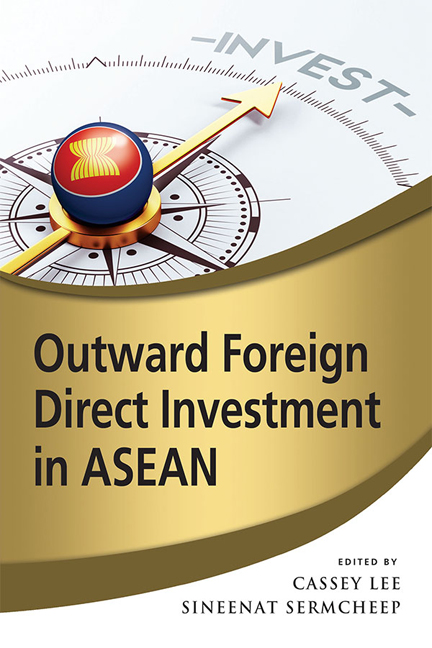Book contents
- Frontmatter
- Contents
- List of Tables
- List of Figures
- Foreword
- About the Contributors
- Introduction
- 1 The Rise of Outward Foreign Direct Investment from ASEAN
- 2 ASEAN's Outward Foreign Direct Investment
- 3 The Impact of the ASEAN Economic Community on Outward FDI in ASEAN Countries
- 4 Determinants of Singapore's Outward FDI
- 5 Outward Foreign Direct Investment from Malaysia
- 6 Indonesia's Outward Foreign Direct Investment
- 7 Factors Influencing Thailand's Outward FDI
- 8 Outward Foreign Direct Investment: The Case of Vietnam
- 9 Myanmar as a Destination for OFDI: A New ASEAN Foreign Investment Frontier
- Index
8 - Outward Foreign Direct Investment: The Case of Vietnam
Published online by Cambridge University Press: 19 May 2017
- Frontmatter
- Contents
- List of Tables
- List of Figures
- Foreword
- About the Contributors
- Introduction
- 1 The Rise of Outward Foreign Direct Investment from ASEAN
- 2 ASEAN's Outward Foreign Direct Investment
- 3 The Impact of the ASEAN Economic Community on Outward FDI in ASEAN Countries
- 4 Determinants of Singapore's Outward FDI
- 5 Outward Foreign Direct Investment from Malaysia
- 6 Indonesia's Outward Foreign Direct Investment
- 7 Factors Influencing Thailand's Outward FDI
- 8 Outward Foreign Direct Investment: The Case of Vietnam
- 9 Myanmar as a Destination for OFDI: A New ASEAN Foreign Investment Frontier
- Index
Summary
INTRODUCTION
Since the launch of market-oriented economic reforms in 1986, Vietnam has become one of the fastest growing countries in Southeast Asia. During this period, the Vietnamese government has quickly joined the competition for inward foreign direct investment by restructuring the domestic economy and by opening its economy to the external trade and investment.
Foreign direct investment (FDI) is one of the most significant features of Vietnam's movement from a planned economy to a market economy. Since Vietnam's government regulations on foreign investment abroad were signed in 1999, the number of outward FDI (OFDI) projects as well as registered capital has increased steadily. In 2013, the registered capital of Vietnam's outward FDI was more than 157 times of that in 2003 and 789 times of that in 1999. The average registered capital of Vietnam's FDI outflow annually amounted to US$887.5 million. The average value of a project is about US$23.9 million. Although Vietnam's outward direct investment is still small relative to its huge inward FDI, it increased dramatically in Vietnam over time. So how has Vietnam's OFDI performed since economic reforms were carried out in 1986? What are the prospects for the country's OFDI? What policies has the country implemented to increase its direct investment overseas in the long run? This study intends to address these specific questions.
The structure of this chapter is organized as follows. Section 2 presents an overview of the Vietnamese economy's performance. Section 3 briefly shows the development of outward FDI policies in Vietnam. The next section presents the current state of OFDI in Vietnam. Section 5 explains the prospects of Vietnam's FDI outflows. The final section deals with conclusions and policy implications.
THE PERFORMANCE OF VIETNAM's ECONOMY
After Vietnam gained independence in 1975, the country adopted a centrally planned economic regime. This economic model under this regime was based on the classic Soviet-type command economy with strong governmental control over all economic decisions. At this time, all of economic decisions were taken by the State, not by the market. The State not only assumed management functions such as issuing policies, laws, regulations, monitoring and inspecting foreign trade activities, it also fulfilled the functions of guiding business decisions such as fixing the list of trade products, trade markets, and export-import prices.
- Type
- Chapter
- Information
- Outward Foreign Direct Investment in ASEAN , pp. 180 - 201Publisher: ISEAS–Yusof Ishak InstitutePrint publication year: 2017



